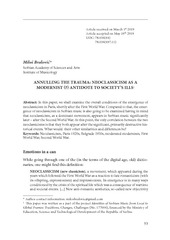Приказ основних података о документу
Annulling the Trauma: Neoclassicism as a Modernist (?) Antidote to Society’s Ills
| dc.contributor | Veselinović-Hofman, Mirjana | |
| dc.creator | Bralović, Miloš | |
| dc.date.accessioned | 2019-07-03T11:03:27Z | |
| dc.date.available | 2019-07-03T11:03:27Z | |
| dc.date.issued | 2019 | |
| dc.identifier.issn | 0354-818X (print) | |
| dc.identifier.issn | 1821-3782 (online) | |
| dc.identifier.uri | http://ojs.newsound.org.rs/index.php/NS/article/view/No.53_53-69/6 | |
| dc.identifier.uri | https://dais.sanu.ac.rs/123456789/6278 | |
| dc.description.abstract | In this paper, we shall examine the overall conditions of the emergence of neoclassicism in Paris, shortly after the First World War. Compared to that, the emergence of neoclassicism in Serbian music is also going to be examined having in mind that neoclassicism, as a dominant movement, appears in Serbian music significantly later – after the Second World War. At this point, the only correlation between the two neoclassicisms is that they both appear after the significant, primarily destructive historical events. What would their other similarities and differences be? | en |
| dc.description.abstract | The First World War ended a hundred years ago. This historical event of colossal proportions significantly changed both European and world history. And it is very probable that in the following years (that is, the 1920s), this event influenced many ’calls to order’, to paraphrase the title of Jean Cocteau’s infamous 1923 essay. Therefore, in this paper, we first examined (in the most general terms) overall historical conditions which influenced the emergence of neoclassicism in Paris, before and shortly after The Great War. With this in mind, we also examined the overall conditions of the emergence of neoclassicism in Serbian music, which (acknowledging several modest attempts before The Second World War) appeared as a (sort of) dominant movement significantly later, compared to its French counterpart, that is, in the 1950s. At this point, the only correlation between the two neoclassicisms is that they both appear after significant, primarily destructive, historical events. Therefore, having in mind that after two wars of vast proportions, contexts changed, we examined the ways by which the composers (that is Igor Stravinsky and Milan Ristić, as case studies) tried to find a stable way into mainstream art and, to some extent, redevelop their poietics. | en |
| dc.language.iso | en | sr |
| dc.publisher | Belgrade : Faculty of Music | sr |
| dc.relation | info:eu-repo/grantAgreement/MESTD/Basic Research (BR or ON)/177004/RS// | sr |
| dc.rights | openAccess | sr |
| dc.rights.uri | https://creativecommons.org/licenses/by-nc-nd/4.0/ | |
| dc.source | New Sound International Journal of Music | sr |
| dc.subject | Neoclassicism | sr |
| dc.subject | Paris 1920s | sr |
| dc.subject | Belgrade 1950s | sr |
| dc.subject | moderated modernism | sr |
| dc.subject | First World War | sr |
| dc.subject | Second World War | sr |
| dc.title | Annulling the Trauma: Neoclassicism as a Modernist (?) Antidote to Society’s Ills | en |
| dc.type | article | sr |
| dc.rights.license | BY-NC-ND | sr |
| dcterms.abstract | Браловић, Милош; | |
| dc.citation.spage | 53 | |
| dc.citation.epage | 69 | |
| dc.citation.issue | 53 | |
| dc.identifier.cobiss | 102800647 | |
| dc.type.version | publishedVersion | sr |
| dc.identifier.fulltext | https://dais.sanu.ac.rs/bitstream/id/19683/Bralovic_Annuling_the_Trauma.pdf | |
| dc.identifier.rcub | https://hdl.handle.net/21.15107/rcub_dais_6278 |

